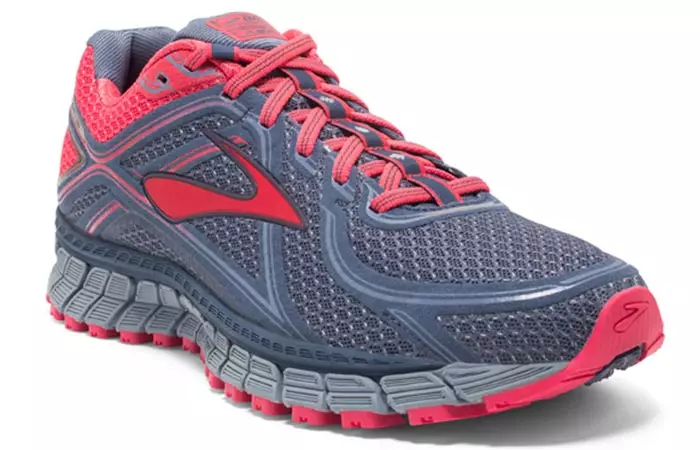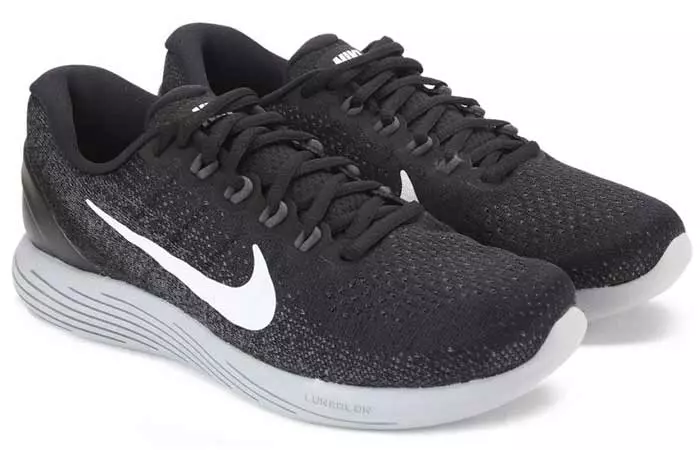11 Best Running Shoes For Flat Feet (Overpronation)
Top running shoe options for flat feet to ensure optimal support and cushioning.

Image: Shutterstock
Not many of us understand what flat or arched feet are and why some people complain about them so much. But the ones who have flat feet can tell you what a harrowing experience running or any other physical exertion can be. Funnily, some of us do not even realize that we suffer from something called the flat feet, or there’s something up with our feet until we start having difficulties. But, thanks to the innovation in designs, brands have got our backs, and now we actually can choose the perfect athletic footwear for us from among quite a few big names depending on our budget, style, and other preferences. If you are still wondering what flat feet are, how they look, and how to go about choosing shoes – we got this. Read on to find out the best running shoes for flat feet.
 Ace The Look
Ace The Look- Comfort: A wide toe box, strong heels, and a good arch provide support and traction and prevent injuries and swelling.
- Occasion: Pair running shoes with your favorite pair of ankle-length jeans or leggings and an oversized shirt or sweater. You can also pair it with a summer dress or a knee-length skirt.
- Color: Pair bold-designed running shoes with darker jeans and neutral-shade shoes for lighter ones. With a colorful dress, pair white, black, or neutral-colored running shoes to balance out your look.
- Style: Wear ankle-length socks for a clean look. They highlight your shoes and avoid bunching at the ankles.
In This Article
What Are ‘Flat Feet’? And, How Do They Look?

Our body is engineered so perfectly, and how. We realize this only when there’s a deformity – and flat feet are one such example. Normal feet arch at the sides and do not come in contact with the floor entirely, balancing out the weight with a spring-like action between the front part of the feet and the rear. All of this is connected to the lower part of the leg, and affects the overall functionality. The absence of these arches causes the feet to touch the ground entirely, and the condition is called ‘Flat Feet’.
Some people might not have absolute flat feet but an arch that is smaller than it should be, while for some it is unilateral – or just for one foot. The image is an excellent reference to understand what flat feet look like, but it is best to visit a physician or an orthopedic when in doubt. There are mainly two main types of flat feet — rigid and flexible. Rigid flat feet do not have an arch, both when standing or sitting. People with this kind of feet need shoes with adept cushioning and stability to keep their body aligned. On the other hand, flexible flat feet lack an arch when standing but display an arch when in a relaxed sitting position. Such people need shoes with moderate arch support and cushioning.
Mariam Kashif, a blogger, shares her son’s diagnosis of flat feet and her experience of dealing with issues that followed. She writes, “Long story short, his feet started worsening at 4, and it always concerned me. I’m a flatfoot myself.” She says that the doctor at the time recommended insoles. His gait was definitely affected, and he stayed away from on-ground sports, apart from swimming. But the situation worsened when he started playing football, and thus kept spraining his foot, where one day he hurt himself badly. She continues, “The doctor looked at his feet, and we got the most SHOCKING news (shocking for us because we were not expecting it). He looked at his X-rays, examined his feet, and recommended SURGERY (i).”
 Trivia
TriviaKey Takeaways
- Running shoes for flat feet are engineered to offer comfort and stability during running activities.
- The supportive arch structure and cushioning help distribute the weight evenly and reduce overpronation, which is common in flat-foot runners.
- These shoes also improve your running performance, reducing the risk of injuries associated with overpronation.
How To Choose Flat Feet Shoes
The inner arches act as shock absorbers and help with weight distribution, etc., and since that is not present in people with flat feet, you need something that can suffice and make up for it. There are shoes that come with in-built raised insoles that give your feet the support and cushioning they need. While there are special orthopedic-certified shoes you can purchase from surgical stores, there are other stylish options too. When choosing shoes, it is essential to measure shoe size correctly to ensure proper support. There is a standard guide that lets you understand how to measure shoe size to get the right shoe for optimal comfort and support. Once you have determined your shoe size, compare it with the brand’s measurements before buying. You may also test the shoes in person to determine the level of support and comfort. Press gently on the insole to examine its firmness, understanding how much arch support you are getting. Determine the shoes’ stability by walking or jogging in them. If you face repeated inward rolling, know that the shoes are not the best for you. Next, check the cushioning by doing fast jumps. Check how well the shoes absorb the shock and impact. If you are still unsure, consider visiting a specialty running store for a gait analysis. They will assess your walk and movement in the shoes and tell you whether they align with your foot dynamics. It is best to try on different shoes and test them thoroughly before making the final purchase. Now, let us take a look at some brands that make comfortable and fabulous-looking footwear for those with flat feet.
11 Best Running Shoes For Flat Feet (Overpronation)
1. Brooks Adrenaline

You would not normally pay attention to these things, but if you are suffering from flat feet or cannot take the pressure from high-intensity workouts, go for the best of the lot – Brooks. Brooks has a lot of variants that help people with pronation and underpronation, but ‘Adrenaline’ is by far the best. It has something called the DNA midsole that gives you extra cushioning and stability. It has a great grip and is good for all terrains and weather conditions. It’s worth everything you put into buying these shoes.
 Trivia
Trivia2. Asics Gel Kayano

Asics, as you know, is one of the best in the industry and a go-to brand for sports apparel, shoes, and accessories. Kayano from Asics is specifically meant to help overpronation and people suffering from sensitive soles that prevent them from enjoying exercise and other physical activities. There are other versions in this, but the latest Gel Kayano shoes come with an improved fit, gait control, shock absorption, and cushion support. Plus, these are highly durable. Mobility and injury prevention specialist Dominion Ezechibueze says, “I have run track competitively for over 5 years and Asics was a go-to for me and lots of teammates. Their shock absorption technology within the shoes is superior. So, for beginners to intermediate runners, this is a great choice.”
3. New Balance Fresh Foam Vongo

New Balance shoes are all about being lightweight, comfortable, and breathable shoes that make your running experience as seamless as it can be. They cushion your feet without compromising on the style. These are one of the best in the line and provide durability and balance like no other.
4. Nike Lunar Glide 9

Nike is an industry leader. Its innovative designs cater to all kinds of industry specifications, and there’s a separate stability category that takes care of overpronation too. The Lunar Glide 9 is the best from this category as it cushions the inner arch of your feet the right way and gives them the stability they need without putting too much pressure. The breathable knitwear material is another significant add-on to these shoes, while the flywire cables give your feet excellent support and keep them cool.
5. Mizuno Wave Inspire 13

If you are a runner or want to get into running but your flat feet or overpronation is dampening your hopes, Mizuno Wave Inspire 13 shoes are what you need. These are specifically designed to support your feet while running and reduce the pressure on your body that falls directly on your flat feet. They are lightweight, stable, shock absorbing, and durable – everything running shoes need to be.
6. Adidas Adistar Boost ESM

The Adistar Boost ESM shoes arch and fit the inner arches of your feet perfectly. They give you great balance and support. The price point is yet another aspect that makes these shoes irresistible. Runners love these for the responsiveness and the traction these shoes provide. Mobility and injury prevention specialist Dominion Ezechibueze says, “The Adistar Boost definitely helps with arch support but as far as total running support, I feel it lacks enough stability on the exterior region of the shoe compared to others in the market. For some people, the arch may help their flat feet forcing them to run on their toes.”
7. Brooks Beast 16

If you have been looking for sports shoes that protect your feet, chances are you stumbled upon Brooks, the Beast edition. They are all about cushion support and take the natural shape of your feet and have something called the Extended Progressive Diagonal Rollbar with better motion control. Look no further than the Brooks Beast 16, I tell you.
8. Saucony Freedom

Saucony specializes in making shoes that provide stability and constant cushioning to your feet. They hug your feet and take their shape, keeping them comfortable the entire time. They are lightweight, dynamic and one of a kind. You pick any random variant from Saucony – and you won’t go wrong.
9. Under Armor Spectre

Under Armor is known for its cutting-edge sporting goods and affordable accessories. Spectre from Under Armor comes with an internal heel counter to cushion your heel and protect them from pressure when they come in contact with the ground. It is extremely flexible, light, easy on your body, and helps reduce heel pain. Mobility and injury prevention specialist Dominion Ezechibueze says, “The Under Armor Spectre is an ideal shoe for individuals with flat feet and heel pain. I really like the heel counter and how light the shoe is with all the cushioning it has.”
10. HOKA Bondi 5

If you are a seasoned runner, you would have heard of HOKA. It makes shoes for runners suffering from plantar fasciitis and flat feet. Bondi from HOKA is specially designed to help runners with hard terrains and hikes, and give them support for extended periods.
11. Skechers GoRun Shoes

The Skechers GoRun range is a versatile collection of running shoes that offer the perfect blend of comfort, innovation, and style for both men and women. Key features include the ultra-light midsole for lightweight cushioning, the breathable Air-Cooled Goga Mat insole for high-rebound support, and M-Strike technology to promote an efficient stride. The brand has designs for every runner’s needs, with options for prioritizing stability, cushioning, or flexibility. The popular GoRun Consistent model stands out with its leather and mesh upper, responsive cushioning, and comfortable insole, making it suitable for running and training. These technical features are wrapped in various colors and designs, ensuring that every runner finds their perfect match for performance and style.
Infographic: Top 5 Running Shoes For Flat Feet
Flat feet can cause immense pain if we don’t wear the right running shoes. If you are looking for shoes that provide the right arch support and comfort while running, you have come to the right place. We have rounded up the top 5 running shoes that will provide a painless and seamless running performance and experience. Check out the infographic below to know more! Illustration: StyleCraze Design Team
Running and other high-impact fitness activities can lead to injuries and foot pain if you do not use proper gear, especially if you have flat feet and are not using suitable shoes to support them. We hope this list of some of the best running shoes for flat feet will help you pick the right shoes. Please do not overlook the limitations of your condition and be mindful during your workout sessions. Subsequently, it will be helpful to consider consulting medical experts if you have had previous injuries.
Illustration: Best Running Shoes For Flat Feet (Overpronation)
_illustration.jpg.webp)
Image: Stable Diffusion/StyleCraze Design Team
Frequently Asked Questions
How can someone with flat feet determine the right fit and size for their running shoes?
You can use these simple tips to help determine the right fit and size for running shoes. Measure the distance between your longest toe and the end of the shoe. Also, ensure you have enough space to pinch some material on the sides or the top of the shoes. Keep in mind that running shores are around a half-size larger than your normal shoe size.
How can someone with flat feet determine the level of support they need in a running shoe?
Stand barefoot and take a look at the inner portion of your feet to determine the level of support required. Check how flat your feet are and see whether they have a tiny arch, a low arch, or a moderate arch. This will help you buy shoes that provide adequate support and cushioning while running.
Are there any tips for breaking in new running shoes for flat feet?
Get out for a walk or a light jog for 5-10 miles. Also, make sure you wear running socks with cushioning to help absorb the shock and provide comfort while running.
What are some of the common mistakes people make when choosing running shoes for flat feet?
Many people with flat feet buy running shoes without considering the type of flat feet, body type, knees, hips, or type of movement. Make sure you have all your measurements ready before buying your running shoes.
Check out this video and learn why motion-control running shoes are essential for those with fleet feet. It delves into the science behind these shoes, offering valuable information for runners.
Personal Experience: Source
StyleCraze's articles are interwoven with authentic personal narratives that provide depth and resonance to our content. Below are the sources of the personal accounts referenced in this article.
i. The Journey We Started With Flat Feethttps://medium.com/@mariamkashif86/the-journey-we-started-with-flat-feet-1842dd621c32
References
Articles on StyleCraze are backed by verified information from peer-reviewed and academic research papers, reputed organizations, research institutions, and medical associations to ensure accuracy and relevance. Read our editorial policy to learn more.
- Foot strength and stiffness are related to footwear use in a comparison of minimally- vs. conventionally-shod populations
https://www.ncbi.nlm.nih.gov/pmc/articles/PMC5829167/
Read full bio of Dominion Ezechibueze
Read full bio of Pratima Ati
Read full bio of Shatabdi Bhattacharya
Read full bio of Srijita De


















Community Experiences
Join the conversation and become a part of our empowering community! Share your stories, experiences, and insights to connect with other beauty, lifestyle, and health enthusiasts.